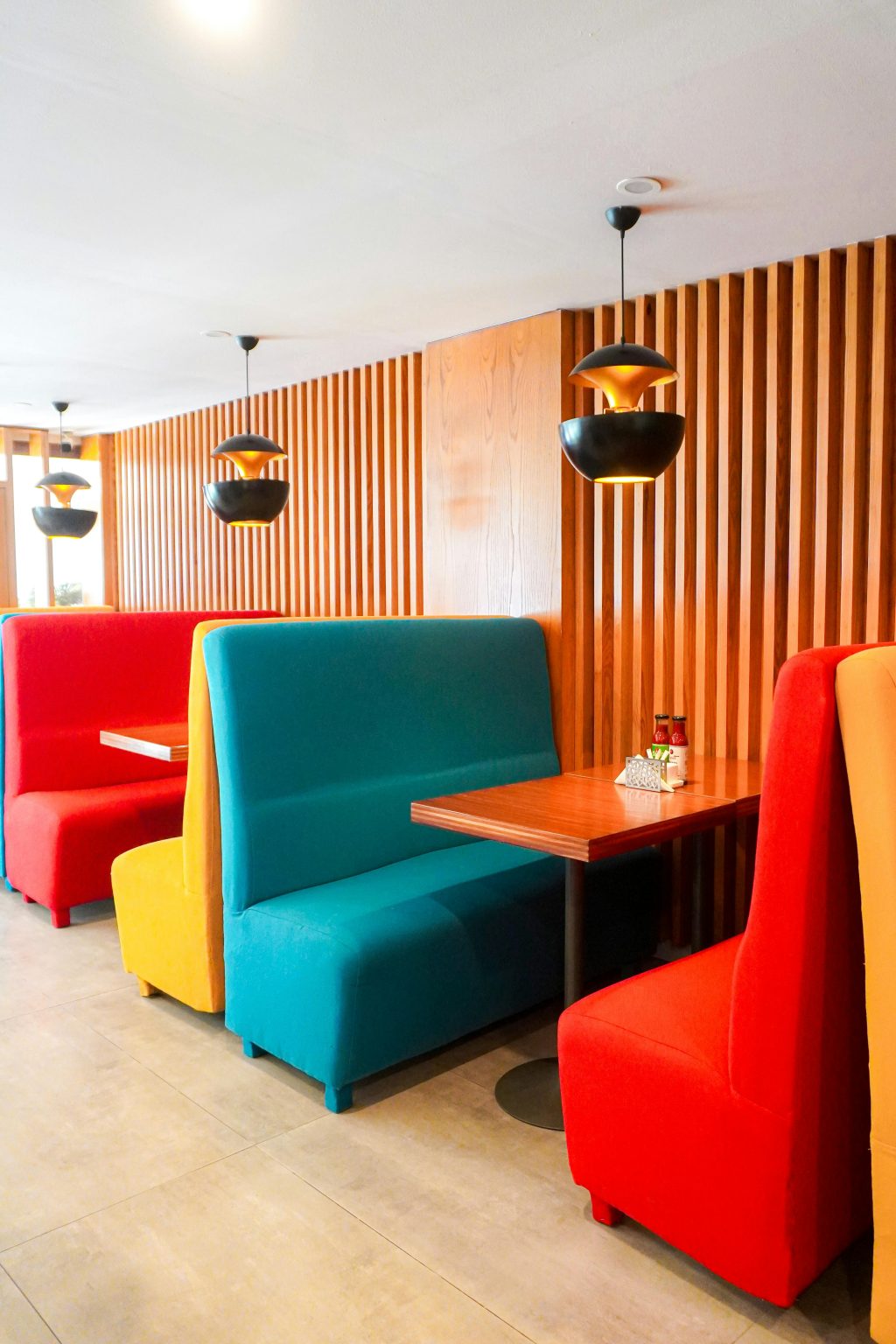You walk into a restaurant & the first thing that hits you isn’t the smell of food or the sight of the décor. It’s the wall of sound. Conversations bleeding into each other, cutlery clattering, chairs scraping across floors. Most places just accept this chaos as part of the “atmosphere.” But some venues get it right.
High-back booths aren’t just about looking fancy or giving people somewhere to hide from their ex across the room. They’re acoustic workhorses that can transform a cacophonous dining space into something bearable. Something where people actually want to linger.
Why Noise Matters More Than You Think
Here’s something that’ll surprise you. Studies show that excessive noise levels can reduce customer dwell time by up to 30%. That’s not just uncomfortable guests leaving early, that’s money walking out the door.
Think about it from your own experience. When was the last time you stayed for dessert in a place where you had to shout to be heard? Probably never. Background noise above 70 decibels makes conversation difficult & stressful. Most busy restaurants clock in at 80-85 decibels during peak hours.
The human ear wasn’t designed for this kind of sustained assault. People get tired. They get irritable. They order faster & leave quicker. Restaurant owners might think a buzzing atmosphere equals success, but there’s a fine line between energetic and exhausting. High-back booths help you stay on the right side of that line.
I’ve watched this play out countless times. Tables in open areas turn over faster, sure, but the per-customer spend is often lower. People in quieter booth sections order more drinks, take their time with dessert, sometimes even order another round.
The Science Behind Sound Absorption
High-back booths work because of basic physics, though most venue owners don’t realise the science behind what they’re installing.
Sound waves behave predictably. They bounce off hard surfaces (think exposed brick walls, concrete floors, glass windows) & get absorbed by soft ones. The tall backs of these booths, especially when upholstered, create vertical barriers that intercept sound waves before they can travel across the room.
But it’s not just about height. The materials matter enormously. A booth with thin vinyl over plywood won’t do much for acoustics. You need proper upholstery with decent padding underneath. Fabric choices make a difference too, though I’ll admit the technical details of absorption coefficients can get pretty dry.
The shape matters as well. Those curved booth backs aren’t just comfortable, they help scatter sound waves rather than reflecting them directly back into the space. It’s surprisingly elegant engineering disguised as furniture.
Most people don’t consciously notice good acoustics. They just know they feel more relaxed, can hear their conversation partner clearly, & aren’t shouting by the end of the evening.
Creating Zones Within Busy Spaces
One of the cleverest things about high-back booths is how they carve up a large space without building actual walls.
Open plan restaurants can feel impersonal & overwhelming. Too many visual & auditory distractions. But section off areas with booth seating & suddenly you’ve created intimate pockets within a larger venue. Each booth becomes its own little dining room.
This zoning effect works on multiple levels. Visually, the high backs provide privacy & reduce the sense of being in a fishbowl. Acoustically, they contain conversations within smaller areas rather than letting them spill across the entire room. It’s like having multiple smaller restaurants operating within one space.
The psychological impact is considerable. Diners feel more secure, more able to have private conversations. Business meetings become possible in what might otherwise be unsuitable environments. Date nights don’t require shouting sweet nothings across a table.
Material Choices That Actually Work
Not all booth materials are created equal when it comes to sound management. I’ve seen plenty of venues install beautiful looking seating that does absolutely nothing for acoustics.
Leather looks luxurious but it’s essentially a hard surface acoustically speaking. It’ll reflect sound just like any other non-porous material. If you’re going for leather, you need substantial padding underneath to get any absorption benefits.
Fabric upholstery is generally better for sound absorption, particularly textured weaves that trap sound waves.
The backing material is crucial too. High density foam provides good absorption while maintaining comfort. Some manufacturers now offer acoustic foam specifically designed for restaurant seating, though it tends to cost more than standard options.
Booth height is another consideration. You need at least 1.2 metres of back height to create meaningful sound barriers. Lower backs might look more open & airy, but they won’t do much to contain noise. The trade off between aesthetics & acoustics is real.
I think the sweet spot is around 1.4-1.5 metres. High enough to be effective, not so high that diners feel boxed in.
Layout Strategies for Maximum Benefit
Randomly scattering high-back booths around your venue won’t maximise their acoustic potential. Strategic placement can multiply their effectiveness.
The best approach I’ve seen involves creating buffer zones between different areas of activity. Position booths between the bar area & dining space, for instance. The high backs help prevent bar noise from washing over diners.
Back-to-back booth arrangements work particularly well. You’re essentially creating a double-height barrier with upholstered surfaces facing both directions. The sound absorption is maximised while you’re using floor space efficiently.
Corner placements can be highly effective too. The booth back combines with existing walls to create an almost cocoon-like acoustic environment. These corner booths often become the most requested tables because they feel so comfortable & private.
Avoid placing booths directly opposite hard walls where possible. The sound just bounces back & forth creating an echo effect. Better to angle them or ensure there’s some distance between the booth & any hard surfaces.
Traffic flow matters as well. High-back booths positioned along major walkways can help shield other diners from the noise of passing staff & customers.
Cost Considerations & ROI
High-back booths cost more than standard seating. There’s no getting around that fact.
You’re looking at anywhere from £800 to £2,500 per booth depending on size, materials & customisation. That’s significantly more than regular chairs & tables. For a venue installing 15-20 booths, the investment can easily reach £25,000 or more.
But here’s where it gets interesting. The return on investment often justifies the expense through increased customer satisfaction & longer dwell times. If booth seating increases average spend per customer by even £3-4, the payback period is usually under two years.
There are hidden costs too. High-back booths are heavier & more complex to install than standard furniture. They require more space per seat, potentially reducing overall capacity. Maintenance can be more involved, particularly for upholstered pieces.
However, the competitive advantage of offering genuinely comfortable, quiet seating shouldn’t be underestimated. In busy hospitality markets, anything that differentiates your venue & encourages repeat visits is valuable.
Some operators have found that booth sections can command slightly higher prices or attract more profitable customer segments willing to spend more for comfort.
Common Mistakes to Avoid
I’ve seen venues spend serious money on booth seating & completely miss the acoustic benefits through poor planning.
The biggest mistake is treating booths purely as aesthetic elements rather than functional acoustic tools. Choosing materials based solely on appearance usually results in expensive furniture that doesn’t actually solve noise problems.
Another common error is insufficient height. Those trendy low-back “booth style” seats might look contemporary but they offer minimal sound control. If you’re investing in booths specifically for acoustic benefits, don’t compromise on height.
Poor spacing is problematic too. Cramming booths too close together negates their noise-reducing properties. You need adequate space between seating areas for the acoustic benefits to work properly.
Some venues go overboard & install nothing but high-back booths. This can make a space feel divided & claustrophobic. Balance is essential. Mix booth seating with other options to maintain variety & accommodate different customer preferences.
Ignoring maintenance requirements is another pitfall. Upholstered booth backs collect dust, food particles & stains more readily than simple chairs. Factor ongoing cleaning costs into your calculations.
Perhaps most importantly, don’t expect booths alone to solve severe acoustic problems. They’re part of the solution, not a magic fix for fundamentally poor venue acoustics.
The Bottom Line
High-back booths represent one of the most practical approaches to managing noise in busy hospitality environments. They’re not a trendy gimmick or purely aesthetic choice, they’re functional pieces of equipment that can measurably improve customer experience.
The acoustic benefits are real & quantifiable. Sound absorption, noise containment, & the creation of quieter zones within larger spaces. These translate directly into longer customer stays, higher spend per visit, & improved satisfaction scores.
That said, they’re not suitable for every venue or situation. The investment is substantial & the space requirements mean you’ll accomodate fewer customers per square metre. But for establishments struggling with excessive noise levels or looking to differentiate themselves through enhanced comfort, booth seating can be transformative.
The key is treating them as acoustic solutions first & decorative elements second. Choose materials for performance, plan layouts strategically, & maintain them properly. Done right, high-back booths can turn a noisy, uncomfortable dining room into somewhere people genuinely want to spend time & money.



